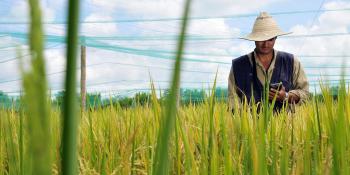Monitoring shifting weather patterns in Sri Lanka for climate adaptation in agriculture

by Sarath Nissanka, University of Peradeniya, Sri Lanka
Despite its relatively small aerial extent, Sri Lanka exemplifies a variety of climatic conditions depending on the geographical settings of respective locations. Being an island in the Indian Ocean, the country shows very typical maritime-tropical temperature conditions. These conditions are characterized by moderate average temperatures in comparison with the more continental tropics. Temperature conditions in Sri Lanka are also characterized by a significant temperature decrease in the central highlands according to the atmospheric lapse rate. With the climate of Sri Lanka changing over the past few decades, investigation of how weather patterns change across different agro-ecological regions, drifting of seasons, and occurrence of region-specific extreme weather events and their impacts is essential to develop possible adaptation & mitigation mechanisms.
Assessment of the variation of temperature regime in all seven agro-climatic-zones that lie within the three major climatic-zones of Sri Lanka from 1960-2010 were done, namely, Wet [Low-Country-Wet-Zone(LCWZ), Mid-County-Wet-Zone(MCWZ), Up-Country-Wet-Zone(UCWZ)], Intermediate [Low-Country-Intermediate-Zone(LCIZ), Mid-County-Intermediate-Zone (MCIZ), Up-County-Intermediate-Zone(UCIZ)] and Dry-zones [Low-Country-Dry-Zone(LCDZ)]. A significant increase of mean annual average temperature was observed in all regions having a range of 0.00970C/year to 0.02580C/year, with an average increase of 0.80 C during the past five decades. A significant increase of maximum temperature was observed in most locations with a range of 0.01230C/year (LCWZ) to 0.03360C/year (LCDZ). Meanwhile, nighttime minimum temperature in all regions showed an increasing trend with a range of 0.00720C/year (LCDZ) to 0.02470C/year (UCWZ) except in one location in LCIZ. Diurnal temperature range showed a decreasing trend in almost all locations in the Wet-zone with minor exception in MCWZ. This reduction was mainly attributed to the increasing nighttime minimum temperature in respective regions. However, diurnal temperature range showed an increasing trend in almost all agro-climatic zones of the Dry and Intermediate-zones. It was mainly attributed to the sharp increase in daytime maximum compared to nighttime minimum temperatures in those regions. Results of this study confirms that atmospheric temperature regime in all agro-climatic regions of the island is increasing with a web of potentially negative impacts on crop production.
More information
Read more about Climate Change, Agriculture and Food Security work in South Asia.
To get more updates on our research in South Asia, follow us on Facebook and Twitter @Cgiarclimate.
This blog post was written by Sarath Nissanka, University of Peradeniya, Sri Lanka


